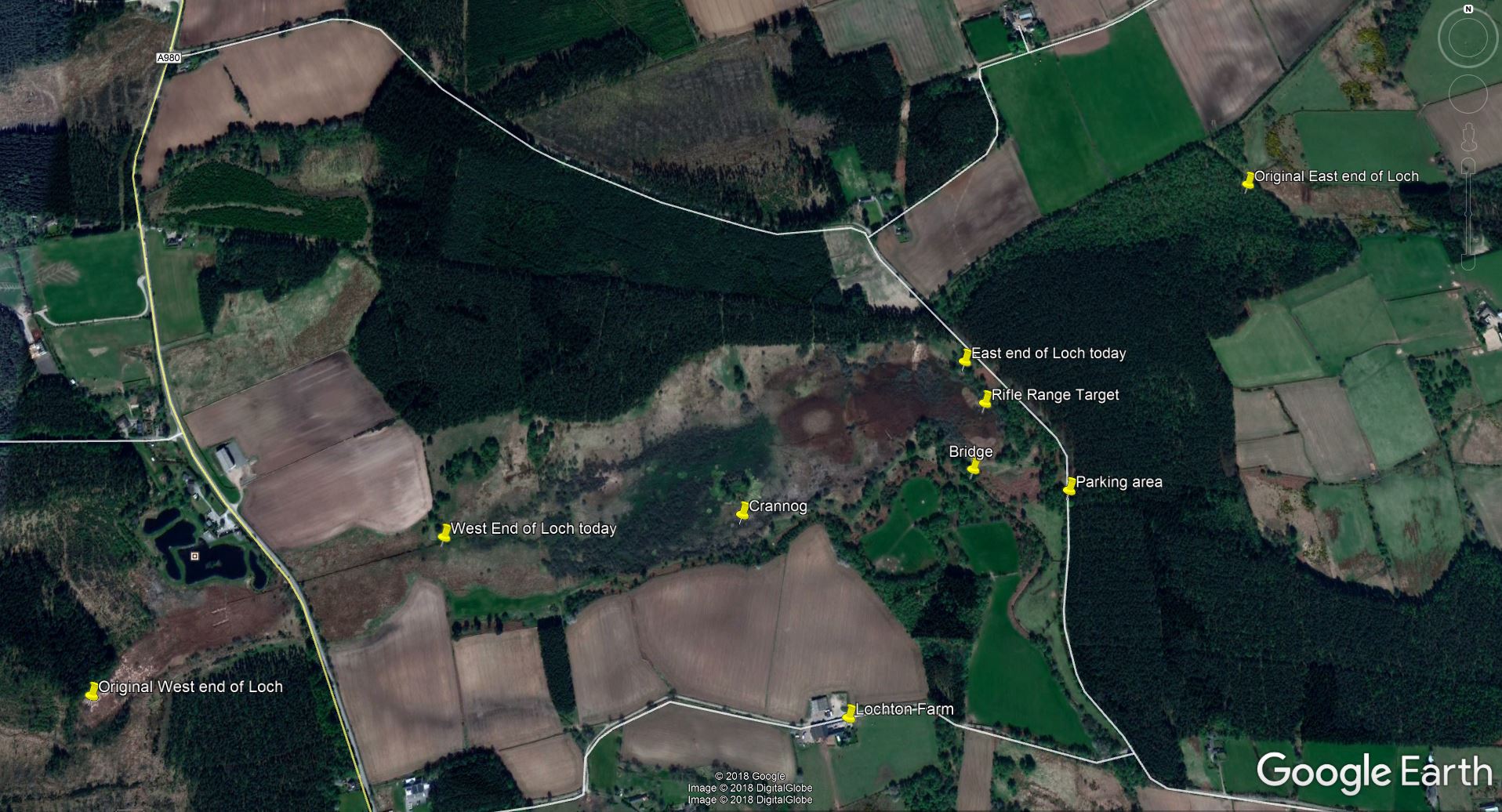Directions to the Loch of Leys to View the Crannog
- East end of Banchory. Turn off the A93 beside Tesco signed to Hirn / Echt
- 300 m turn right to Hirn / Echt.
- 300 m turn left.
- After 500 metres at junction by small bridge, continue straight ahead. Don’t turn left.
- After 350 m you reach a place to park on the left beside a row of stones
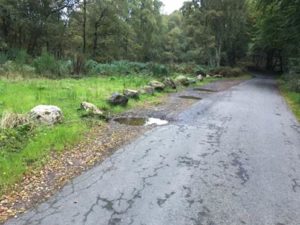
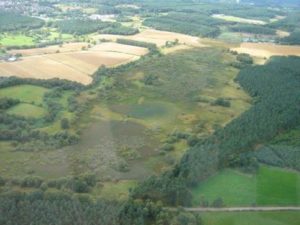
- Leave the car beside the stones and follow the path which starts at the far end of the stones
- After c180 paces you cross a ditch which is the outflow of the Loch
- After about 60 paces, you will see a small roofless granite building about 50 m to your left. This is the ammunition store for a former rifle range. There are the remains of butts evenly spaced along the Loch shore and the now overgrown target mound is at the east end of the Loch.
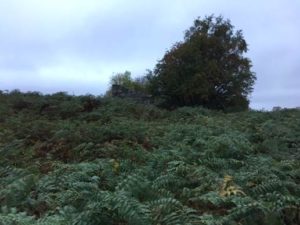
- After c 100 paces from the ditch bridge you should see a stone with a ring about 1 m on the left of the track. This was probably associated with the rifle range for raising a flag when firing but we like to think that it is the mooring place for boats for the Crannog
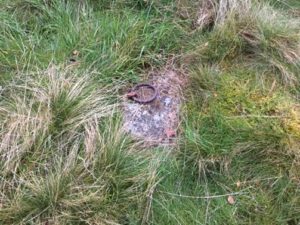
- About 100 m further along the path are a few young scots pine trees. These were planted in memory of a young lady who succumbed to cancer in 1994 and who had the leading role in Tensions in Trust, the community play which was staged at the Castle for the first Burnett Gathering in 1992.
- Most of the bushes along the Loch shore are Blackthorn or Sloe. Sloe Gin is an excellent liqueur. We have made it in the past. The sloe berries are picked after a frost and individually they are pierced to allow the juice to escape. They are then added to gin and sugar. The process is laborious and result not as good as is available in high street and probably more expensive.
- Although you don’t see it easily, the Loch abounds with wildlife. When there was more open water, There were many duck to be seen and there was a colony of black headed gulls which made their nests on little islands of vegetation . This is no more because of the danger of predators. The loch has silted up and vegetation increased. There is a plan and wish to remove much of the vegetation and return it to open water.
- A newcomer to the Loch is the starling. Every evening, starlings congregate before roosting. They arrive in small flocks and then join to become one making impressive patterns in the sky before suddenly dropping into the reeds
- C 325 paces further along the loch shore is the Crannog about 100 m into the loch. It is too wet to attempt to reach it on foot.
Early History
- The designation ‘of Leys’ as applied to the heritor of the Burnard/Burnet lands emerged about 1446 and referred to the property and, in particular, to the area of the Loch of Leys, which was noted in the charter by King Robert the Bruce dated 1323. This included lacum de Banchory cum insula ejusdem or the ‘lake (loch) of Banchory with the island within it’.
- It has been recorded that is a place of very ancient note on account of it being the burial place of St. Ternan, known as the Archbishop of the Picts, who was one of the first Christian missionaries in the north-east predating the arrival in Scotland of St. Columba by about 100 years. Apart from the fact that an island in the Loch of Leys would seem a logical choice of last resting place for such a person, there does not appear to be any positive proof that his grave was there. St. Ternan, traditionally, is said to have been born at Fordoun in Kincardineshire and baptised into Christianity by St. Palladius to whom Fordoun Church was dedicated. He died before 500AD.
- On John Thompson’s 1832 county map of Kincardineshire, the Loch of Leys is depicted with a small building on an island labelled ‘Gowhouse’. While on the First Edition 6” OS map, surveyed here in 1864 it is labelled as ‘Goo House’, which is also the recorded in the New Statistical Account apparently referencing the islet’s use as a nesting site for sea birds.
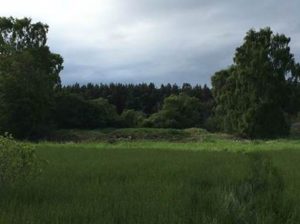
Description
- It is marshy area formed when meltwater, from glaciers moving towards the coast, was left trapped in a depression below the Hill of Fare. The area still carries the vegetative features of marshland with low scrub and reedbeds.
- The Loch, when drained in 1850, covered 140 acres but it could have been 4 or 5 times as large. Alexander Burnard not only received land but also took possession of the crannog, a fortallis, which had been built by the Wachopes and of which they were dispossessed by King Robert. Wachopes/Wauchopes are known to have been holders of land on Deeside in the reigns of Alexander I (1107-1124) and Alexander II (1214-1449).
- The area covered by water before draining can be seen from the following map.
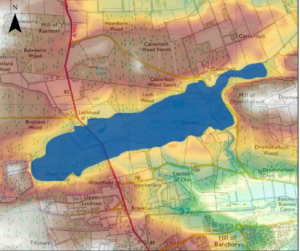
- It is also shown on General Roy’s military survey of 1747-55
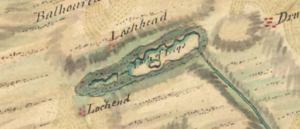
- The loch was drained in two stages. After the first operation, the floor of the loch dropped and there was a second scheme. The ditch which is crossed on the way to the Crannog is the outlet for the water from the loch and is partially lined with stone walling which show the two stages of works. The walls are kept apart with wooden struts thereby demonstrating the need for attention. Do not attempt to view this as it is clearly dangerous.
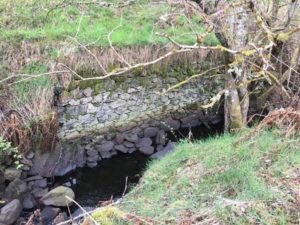
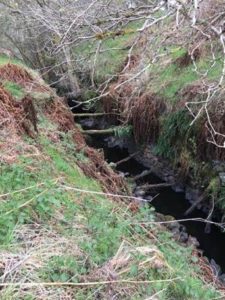
- Burnett’s residence on the crannog lasted no more than 165 years (1323-1488). For that reason, it is certain that the castle would have been built prior to the 16th century
- The crannog, the translation of which from the Gaelic simply means ‘made of wood’, was not confined to Scotland and Ireland nor was it only associated with very early periods of land occupation. Lake dwellings of similar construction existed throughout many parts of the world
Construction
- A crannog was normally constructed by creating an artificial island, or by enhancing an existing natural one, by driving timber piles, usually of alder or oak, into the bed of the loch often in the shape of a circle. Between the piles, and to well above the high-water line, stones were heaped and levelled so that a platform of timber poles could be laid to form a floor.
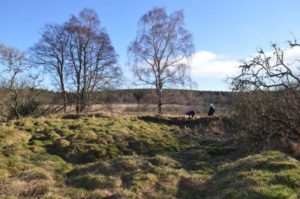
- Excavation of the Leys crannog found it to be composed of earth and stones resting on a foundation of oak and birch trees and surrounded by oak piles. The timber used, along with hazel and alder, was readily available in the vicinity as these were naturally occurring species. Because this was such a valuable resource for the construction of homes, animal shelters, weapons and utensils, the properties of each species were well understood, the timber managed during growth, certain species encouraged by coppicing and any wood used carefully selected.
- The walls of a crannog building were often constructed from wooden hurdles woven from pliable hazel and the roof trusses made from branches thatched with mature reeds which grew profusely as an annual renewable resource. The floor would have been strewn with straw and bracken.
- The heat and cooking source came from a central hearth from which smoke seeped through at roof
Design
- some crannog dwellings were round and others more rectangular in shape, the Leys crannog being one. As the ‘Castle of Leys’ has been described as having been a strong substantial building and rectangular in shape, it is reasonable to assume that the walls would have been constructed predominantly in stone.
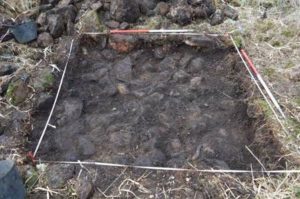
- Of course, depending on the size of the island, a crannog home could have comprised not only the substantial building for the laird and his family but also a collection of other small dwellings for his immediate servants and for crop storage. Supplementary building would most likely have been of timber construction.
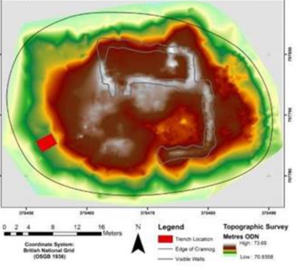
- Recorded information about the Leys crannog comes primarily from the efforts of Sir James Horn Burnett to drain the Loch in 1850 as part of the land improvement movement of that period. He noted in his diary on 23 July of that year Digging at the Loch of Leys renewed. Took out two oak trees laid along the bottom of the lake, one five feet in circumference and nine feet long; the other shorter. It is plain that the foundation of the island has been of oak and birch trees laid alternately and filled up with earth and stones. The bark was quite fresh on the trees. The island is surrounded by oak piles, which now project two or three feet above the ground. They have evidently been driven in to protect the island from the action of the water.
19th Century
- The artifacts found were described by Sir James as being bones and antlers of a red deer of great size, kitchen vessels of bronze, a millstone, a small canoe and a rude flat bottomed boat about nine feet long made from one piece of oak. The canoe, which was raised from the loch bottom, was said to have disintegrated on exposure to the air. There were also some coins found which were then lost because, as Sir James Burnett wrote, one of the workmen ran off with them.
- Some of the vessels found are on display in Crathes Castle, others were lodged with the Scottish Museum of Antiquities (now the Royal Museums of Scotland).
2016
- Topographic Survey Given the strong evidence for the former extent of the loch, it seems most likely that there has been significant subsidence following the drainage of the loch. This would account for the excavation results which seem to suggest an over-all compression of the buried stratigraphy. It can also be assumed that the top portion of the organic-rich loch bottom would have desiccated and subsided following drainage. The added weight of the crannog and castle structure would likely exacerbate this process.
- A single 2x3m trench was opened on the west side of the crannog mound about a metre from where the water meets solid ground. The trench was first opened as a 2x2m trench and was then extended one metre across the width of the trench to the east. A sondage was opened to alleviate flooding problems in the trench and revealed further stratigraphy of the natural lake accumulations below the anthropogenic mound.
- The trench first encountered a thin layer of peaty topsoil containing numerous medium (0.1-0.5m diameter) boulders. These boulders continued into a thicker rubble collapse layer that included frequent small (5-10mm) fragments of charcoal. This terminated unevenly across the trench at a gravelly sand layer that had small bone and charcoal inclusions, but these seem to have been transported by heavy root activity encountered in the trench.
- The surviving walling on top of the mound survives to a maximum height of 0.7m and maximum width of 1.3m which had facing stones on both sides indicating that this was the maximum width of the wall during use.
- The depth of lacustrine sediment encountered also suggest that the loch was not particularly deep. Sediment depths of over 3m have been encountered in other areas of the loch Consolidated gytta was encountered and which indicated a maximum depth of 4.47m. Accounting for between 2-3m of subsidence, would put the depth of the water between 2.47m and 3.47m in the immediate vicinity of the crannog
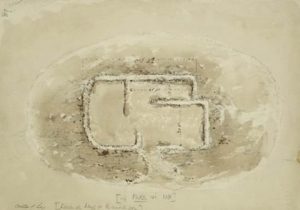
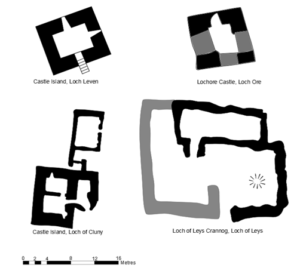
- The walls of 1.3m width are unlikely to be part of a defensive stone construction and not of a stone construction of anything of a great height, like most tower houses. This would suggest that the surviving stone walls at Loch of Leys are the foundations for a timber superstructure rather than an entirely stone-built castle. That would explain their relatively slender form if we assume the castle stood three to four storeys tall like most other tower houses of this date. As such, the Loch of Leys castle would be a rare survival of medieval wooden tower house
- The area of the loch basin is recognised by the Leys Estate for its ecological and cultural value. The vegetation on the island poses a potential threat to the upstanding medieval walling, but this has been managed by the Estate with a programme of felling to protect the walls from tree growth.
